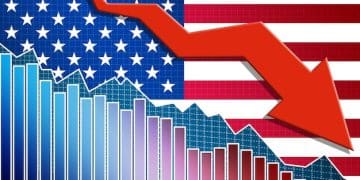New 23% Corporate Tax Rate: Impact on 2025 Business Strategy?

The proposed 23% corporate tax rate could significantly reshape business strategies for 2025 by influencing investment decisions, operational costs, and capital allocation across various sectors in the US.
As the business landscape continually evolves, the potential introduction of a new corporate tax rate of 23% looms large, prompting many companies to re-evaluate their strategic blueprints for 2025. This article delves into how such a change could ripple through various facets of corporate America, from small businesses to multinational giants, potentially reshaping investment, innovation, and global competitiveness.
Understanding the Proposed Corporate Tax Rate
The discussion surrounding a new corporate tax rate, specifically the 23% figure, stems from ongoing debates about fiscal policy and revenue generation. For businesses operating in the United States, understanding the nuances of such a change is paramount. This rate adjustment is not merely a number; it represents a significant shift in the operational environment, influencing everything from daily cash flow to long-term growth projections.
Historically, corporate tax rates in the US have fluctuated, reflecting different economic philosophies and national priorities. The proposed 23% rate aims to strike a balance between stimulating economic activity and ensuring adequate government revenue. Various stakeholders, including economists, policy makers, and business leaders, are weighing in on the potential ramifications, anticipating both challenges and opportunities.
Historical Context of US Corporate Tax Rates
To fully grasp the implications of a 23% rate, it’s essential to look back at the trajectory of corporate taxation in the US. Before the 2017 Tax Cuts and Jobs Act (TCJA), the statutory corporate tax rate was 35%. The TCJA significantly reduced this to 21%, aiming to boost domestic investment and competitiveness. The current proposal represents a modest increase from the TCJA rate, but a substantial decrease from pre-2017 levels.
- 📈 Pre-2017 Era: Statutory rate of 35%, often offset by various deductions and credits.
- 📉 Post-TCJA (2017): Reduced to a flat 21%, simplifying the tax code for many corporations.
- ⚖️ Current Proposal: A potential 23%, signaling a move to increase federal revenue while maintaining a competitive environment.
The motivations behind the proposed increase are multifaceted. They often include the need to fund public infrastructure projects, social programs, or to reduce the national debt. For businesses, this re-evaluation means recalibrating financial models and forecasting tools to accommodate the new tax burden. It also necessitates a deeper dive into how tax liabilities are calculated and what deductions or credits might remain available to mitigate the impact.
Moreover, the discussion extends beyond the mere numerical increase. It encompasses potential changes to other tax provisions, such as accelerated depreciation, research and development (R&D) credits, or international tax rules. These accompanying changes could either exacerbate or alleviate the impact of the higher rate, making a holistic understanding crucial for effective strategic planning.
The policy goal is to achieve a balance: to ensure corporations contribute equitably to public finances while not stifling innovation or deterring investment in the US. Businesses must stay abreast of legislative developments and consider how different scenarios might play out, allowing for agile responses to an evolving tax landscape.
Direct Financial Implications for Businesses
A change in the corporate tax rate directly affects a company’s bottom line. For every dollar of taxable income, a higher rate means a larger portion goes to taxes, leaving less for reinvestment, dividends, or debt reduction. This direct financial impact is perhaps the most immediate concern for corporate executives and financial officers as they prepare their 2025 budgets.
Consider a hypothetical company with $10 million in taxable income. At a 21% rate, their tax liability would be $2.1 million. At 23%, it jumps to $2.3 million – a $200,000 increase in tax payments. While this might seem marginal for large corporations, for small and medium-sized enterprises (SMEs) or businesses with tight margins, such an increase can significantly strain resources.
Impact on Profitability and Cash Flow
Reduced after-tax profits can constrain a company’s ability to retain earnings. This directly impacts cash flow, which is the lifeblood of any business. Lower cash flow can limit a firm’s capacity to invest in new projects, expand operations, or hire additional staff. It can also affect a company’s liquidity, making it harder to meet short-term obligations or withstand economic downturns.
For publicly traded companies, reduced profitability can translate into lower earnings per share (EPS), which often negatively influences stock prices and investor confidence. Analysts and investors closely monitor tax rates as a key variable in valuation models, making a rate hike a significant factor in market perceptions.
Businesses will need to re-evaluate their financial projections and adjust their internal budgeting processes. This might involve setting more conservative profit targets or exploring cost-cutting measures to absorb the increased tax burden. The focus will shift towards optimizing operational efficiency to maintain profit margins despite the higher tax rate.
Influence on Investment and Expansion Plans
One of the most significant long-term effects of a higher corporate tax rate could be its influence on investment decisions. When after-tax returns on investment decline, companies may become less inclined to undertake new capital expenditures, such as building new facilities, upgrading technology, or investing in research and development.
This cautious approach could lead to a slowdown in economic growth. If businesses defer or scale back expansion plans, it has a ripple effect throughout the economy: fewer new jobs, less demand for raw materials and services, and reduced innovation. Foreign direct investment (FDI) into the US could also become less attractive if other countries offer more favorable tax regimes.
Conversely, some argue that the impact might be less severe if the tax increase is seen as funding beneficial public goods (e.g., improved infrastructure) that ultimately enhance the business environment. However, the direct financial calculation often takes precedence for individual firms making investment choices.
Businesses that are highly capital-intensive or rely heavily on retained earnings for growth might feel this impact most acutely. They will need to carefully model the long-term return on investment (ROI) for new projects under the new tax structure and potentially adjust their capital allocation strategies.

Strategic Adjustments for 2025
As the potential 23% corporate tax rate approaches, businesses are not merely bystanders; they are actively strategizing to mitigate negative impacts and leverage any emerging opportunities. This proactive approach involves a re-evaluation of financial models, operational procedures, and even supply chain management to adapt to the new fiscal reality.
One primary area of focus will be tax planning. Companies will work closely with tax advisors to identify legitimate deductions, credits, and other incentives that can legally reduce their taxable income. This meticulous approach to tax compliance becomes even more critical when the statutory rate rises.
Revisiting Capital Allocation and Investment
With less after-tax profit, companies must be more judicious about how they allocate their capital. This could mean a more rigorous review of potential investments, prioritizing projects with higher and quicker returns on investment. Some businesses might shift focus from long-term, speculative ventures to shorter-term, proven opportunities.
- 💡 Prioritize essential upgrades over discretionary expansions.
- 💲 Reassess R&D spending to ensure maximum tax credit utilization.
- 🌍 Evaluate international investment opportunities against domestic ones, considering global tax landscapes.
For businesses with international operations, the interplay between domestic and foreign tax rates becomes even more complex. They might consider re-shaping their global corporate structure to optimize their overall tax burden, potentially re-evaluating the location of intellectual property or manufacturing facilities if the US rate becomes less competitive.
The decision-making process for mergers and acquisitions (M&A) could also be influenced. A higher tax rate might make certain acquisitions less attractive if the integration costs outweigh potential synergy benefits after tax. Conversely, it could spur M&A activity focused on acquiring companies with attractive tax attributes or complementary business models that enhance tax efficiency.
Operational Efficiency and Cost Management
When the tax bill increases, businesses often look internally for ways to absorb the additional cost without passing it entirely to consumers or sacrificing profit margins. Enhanced operational efficiency and stringent cost management become paramount. This involves scrutinizing every line item in the budget to identify areas for optimization.
Companies might invest in automation technologies to reduce labor costs, streamline supply chains to minimize logistics expenses, or renegotiate contracts with suppliers for better terms. The goal is to reduce pre-tax expenses wherever possible, thereby lowering the taxable income base.
This drive for efficiency can also lead to innovation in internal processes. For instance, businesses might adopt new software solutions for better inventory management or implement energy-saving measures to reduce utility bills. While these efforts are generally beneficial, a higher tax rate provides a stronger impetus for their immediate implementation.
For service-oriented businesses, the focus might shift to optimizing client acquisition costs and improving service delivery models to increase per-client profitability. Every aspect of the business process will come under review as companies seek to maintain their financial health in a changing tax environment.
Impact on Specific Business Sectors
While a 23% corporate tax rate would affect all profitable businesses, the degree of impact will vary significantly across different sectors. This is due to variations in capital intensity, profitability margins, global reach, and reliance on specific tax credits or deductions. Understanding these sector-specific nuances is crucial for both businesses within these sectors and those looking to invest in them.
Some sectors, like manufacturing, tend to be highly capital-intensive and benefit significantly from depreciation deductions. Others, such as tech startups, might rely more on R&D credits. The actual tax burden for a specific company or sector often depends on these detailed provisions rather than just the headline rate.
Technology and Innovation
The technology sector, characterized by high investment in research and development, might feel a mixed impact. While a higher corporate tax rate could reduce after-tax profits, the availability and generousness of R&D tax credits could significantly mitigate this effect. If these credits are preserved or enhanced, the sector might continue its robust growth trajectory.
However, venture capital funding, which is crucial for many tech startups, could become more conservative if investors anticipate lower returns due to higher corporate taxes. This could potentially slow down the pace of innovation for nascent companies that rely heavily on external funding.
Large tech companies with significant international operations might also re-evaluate their global tax structures. They could explore strategies to optimize their tax footprint by shifting intellectual property or revenue streams to jurisdictions with more favorable tax regimes, to the extent legally permissible.
Manufacturing and Industrial Sectors
Manufacturing and other industrial sectors are often sensitive to changes in corporate tax rates due to their substantial fixed asset investments and long production cycles. A higher tax rate could reduce the attractiveness of large-scale capital expenditures, potentially slowing down modernization efforts or expansions of production capacity.
These sectors often benefit from accelerated depreciation allowances, which allow companies to write off the cost of assets more quickly, thereby reducing taxable income in the short term. The future of these allowances alongside a higher corporate rate will be a critical factor. If these remain robust, the impact might be less severe than if they are also curtailed.
Furthermore, many manufacturing companies operate globally. The competitiveness of US-based manufacturing could be affected if the new tax rate makes production within the US comparatively more expensive than in countries with lower corporate taxes. This could incentivize some companies to re-evaluate their supply chains and production locations.
Retail and Consumer Goods
The retail and consumer goods sectors typically operate on thinner profit margins compared to, say, technology or finance. For these businesses, even a marginal increase in the corporate tax rate can have a noticeable impact on profitability. This could lead to price increases for consumers, cost-cutting measures, or slower expansion plans.
Smaller retail businesses, which often have limited financial reserves, might find it particularly challenging to absorb a higher tax burden. Their ability to invest in digital transformation, store upgrades, or marketing campaigns could be curtailed, impacting their competitiveness against larger players.
Conversely, for larger, more diversified consumer goods companies, sophisticated tax planning strategies and economies of scale might help them navigate the change more effectively. However, the overarching pressure to maintain profitability in a competitive market will likely drive these businesses to scrutinize every cost.
The direct impact on consumer spending is also a consideration. If the tax increase leads to higher prices, it might dampen consumer demand, creating a challenging environment for retailers. Businesses in this sector will closely monitor consumer behavior and economic indicators to adapt their strategies accordingly.

Global Competitiveness and International Implications
In an interconnected global economy, tax policy decisions in one major country can have far-reaching international consequences. The proposed 23% corporate tax rate in the US is no exception. Its impact on global competitiveness and international business strategies is a critical consideration for both domestic and multinational corporations.
When the US raises its corporate tax rate, it alters the relative attractiveness of investing and operating within its borders compared to other nations. Countries with lower tax rates may become more appealing destinations for capital and corporate headquarters, potentially leading to capital flight or reduced foreign direct investment into the US.
Attracting and Retaining Businesses
A higher corporate tax rate can make the US less competitive in the global race to attract and retain businesses. Multinational corporations evaluating where to locate their operations, invest in new facilities, or domicile their intellectual property often consider the tax environment as a significant factor. If the US rate exceeds that of comparable economies, it could deter new investment.
Conversely, some argue that factors beyond tax rates, such as a stable legal system, a skilled workforce, market size, and infrastructure quality, are equally, if not more, important in attracting businesses. However, the cumulative effect of a higher tax rate combined with other competitive pressures cannot be understated.
Policymakers often weigh the revenue generation benefits of a higher tax rate against its potential impact on economic growth and job creation if businesses choose to expand elsewhere. This ongoing tension makes corporate tax policy a complex balancing act.
The ability of the US to attract and retain high-growth industries, particularly in technology and advanced manufacturing, will depend on maintaining an environment that is not only innovative but also fiscally hospitable. Companies are always looking for optimal locations that maximize after-tax returns.
International Tax Regimes and BEPS Initiatives
The global tax landscape is undergoing significant changes, particularly with initiatives like the OECD’s Base Erosion and Profit Shifting (BEPS) project. These initiatives aim to prevent multinational corporations from avoiding taxes by shifting profits to low-tax jurisdictions.
A higher US corporate tax rate could influence how US-based multinationals structure their international operations in response to BEPS rules. It could also impact agreements on minimum global corporate tax rates, where countries aim to establish a floor for corporate taxation worldwide to prevent a “race to the bottom.”
The interaction between the domestic 23% rate and these international rules will define the overall tax burden for many global players. Companies will need expert international tax advice to navigate these complex regulations and ensure compliance while optimizing their global tax strategy.
The implications extend beyond just US companies. Foreign companies with significant operations or desires to expand into the US will also be impacted by this change. Their strategies for market entry, repatriation of profits, and overall investment in the US will be directly influenced by the new tax landscape. The global chessboard of corporate taxation is constantly shifting, and the US rate change is a major move within it.
Addressing Compliance and Regulatory Challenges
Any change to the corporate tax code introduces new compliance burdens and regulatory challenges for businesses. A move to a 23% rate might seem straightforward on the surface, but the underlying mechanics of tax laws are often complex, requiring deep understanding and meticulous execution. Businesses must prepare not only for the financial impact but also for the operational adjustments necessary to comply with new regulations.
The Internal Revenue Service (IRS) will need to issue new guidance, forms, and instructions to reflect the updated tax rates and any associated changes in deductions or credits. Staying informed about these official pronouncements is a critical aspect of tax compliance.
The Role of Tax Technology
As tax codes become more intricate, the reliance on tax technology solutions grows. Software programs designed for tax preparation, compliance, and planning become indispensable tools for businesses of all sizes. These tools help automate calculations, manage data, and ensure accurate reporting, reducing the risk of errors and penalties.
With a new 23% rate, companies may need to update their existing tax software or invest in new solutions capable of handling the revised calculations and reporting requirements. Integrating these systems with existing financial and accounting software will be crucial for seamless data flow and accurate financial statements.
Furthermore, tax technology aids in scenario planning and financial modeling, allowing businesses to simulate the impact of different tax outcomes on their profitability and cash flow. This foresight is invaluable in making informed strategic decisions for 2025.
Companies that have robust tax technology infrastructure in place will be better positioned to adapt quickly and efficiently to the new tax environment, minimizing disruption to their operations and financial reporting cycles. The investment in such technology will increasingly become a business imperative rather than a mere option.
Adapting Internal Accounting and Reporting Systems
Beyond external tax filing, businesses will need to adjust their internal accounting and financial reporting systems. This includes updating general ledger accounts, adjusting deferred tax assets and liabilities, and re-evaluating valuation allowances based on the new tax rate.
For publicly traded companies, the change will affect their quarterly and annual financial statements, requiring careful disclosure of the impact on effective tax rates and net income. This demands close collaboration between tax departments, accounting teams, and external auditors to ensure compliance with financial reporting standards.
Smaller businesses, while perhaps not facing the same level of complexity as public companies, will still need to ensure their bookkeeping and accounting practices accurately reflect the new tax liabilities. This might involve consulting with external accountants or bookkeepers to ensure proper adjustments are made.
Training relevant personnel on the new tax rules will also be essential. Ensuring that financial teams, from junior accountants to senior financial controllers, understand the implications of the 23% rate is crucial for accurate internal reporting and strategic planning. Comprehensive training can prevent costly mistakes and enhance compliance.
Long-Term Economic and Social Implications
The potential implementation of a 23% corporate tax rate extends beyond immediate business financials, carrying significant long-term economic and social implications. Policies like this are often designed not just for revenue generation but also to influence economic behavior and redistribute wealth or fund public services. Understanding these broader implications provides a holistic view of the potential changes for 2025 and beyond.
Economists debate whether higher corporate taxes primarily fall on shareholders, consumers through higher prices, or workers through lower wages. The incidence of corporate tax—who ultimately bears the burden—is a complex and often contested area of economic study. The real-world impact will likely involve a combination of these factors, varying by industry and market conditions.
Impact on Job Creation and Wages
One of the primary concerns often raised with higher corporate tax rates is their potential effect on job creation and wages. The argument is that if companies have less after-tax profit, they might reduce hiring, slow wage growth, or even consider layoffs to maintain profitability.
Conversely, proponents argue that the revenue generated from higher taxes could be invested in public goods like education, infrastructure, or healthcare, which can boost long-term productivity and job growth. For instance, better infrastructure might reduce logistics costs for businesses, indirectly fostering job creation.
The actual impact will depend on various factors: the overall health of the economy, the competitiveness of labor markets, and how businesses choose to adapt. Some companies might automate processes rather than reduce headcount directly, while others might find ways to absorb the additional cost without immediate job cuts.
For workers, the fear is that higher business costs could translate into stagnant wages or reduced benefits. However, a strong demand for labor and competitive market forces could mitigate this. The true effect will likely unfold over several years, making it a critical area for ongoing observation.
Funding Public Services and Infrastructure
A central rationale for increasing corporate tax rates is to generate more revenue for public services. This additional funding could be allocated to a wide range of areas, including upgrading national infrastructure (roads, bridges, broadband), investing in scientific research, expanding access to education, or strengthening social safety nets.
Improved infrastructure can lower operational costs for businesses and enhance efficiency, while investments in education can lead to a more skilled workforce. These indirect benefits can, in theory, offset some of the direct costs imposed by a higher tax rate, creating a more favorable long-term environment for businesses and society.
The effectiveness of this approach hinges on how judiciously the additional tax revenue is spent. If funds are allocated to high-impact projects that genuinely boost productivity and societal well-being, the overall economic picture could remain strong or even improve despite the higher tax burden on corporations.
Ultimately, the long-term impact on the economy and society will be a complex interplay of the direct financial effects on businesses, their strategic responses, and the government’s utilization of the additional revenue. This broad perspective is essential for stakeholders to understand the full scope of a potential 23% corporate tax rate.
| Key Point | Brief Description |
|---|---|
| 💰 Financial Impact | Higher tax means reduced after-tax profits and constrained cash flow affecting liquidity and reinvestment. |
| ⚙️ Strategic Adaptations | Businesses will revise capital allocation, prioritize efficiency, and scrutinize investment decisions. |
| 🌐 Global Competitiveness | Potential shift in FDI patterns and re-evaluation of international tax structures for multinationals. |
| 📊 Compliance & Tech Needs | Increased need for updated tax technology and internal accounting system adjustments. |
Frequently Asked Questions About the New Corporate Tax Rate
▼
Generally, significant corporate tax rates apply to C-corporations. Small businesses structured as pass-through entities (e.g., S-corps, LLCs, or sole proprietorships) typically have their profits taxed at the owners’ individual income tax rates, not the corporate rate. However, indirect impacts can still apply through economic shifts.
▼
SMEs structured as C-corporations would face higher tax burdens directly impacting their retained earnings and investment capacity. Those structured as pass-through entities might see indirect effects through changes in consumer spending or overall economic activity. All SMEs will need careful financial planning and cost control.
▼
Potentially. If businesses are unable to absorb the increased tax burden through efficiency gains or reduced profits, they might pass on the higher costs to consumers in the form of higher prices for goods and services. This depends on market competition and the elasticity of demand for their products.
▼
Tax credits are direct reductions to the amount of tax a business owes. Unlike deductions, which reduce taxable income, credits reduce the tax bill dollar-for-dollar. Their availability and scope alongside a new 23% rate are crucial. Generous credits (e.g., for R&D) can significantly offset a higher statutory rate.
▼
Businesses should monitor official announcements from the US Treasury Department and the Internal Revenue Service (IRS). Consulting reputable tax advisors, legal counsel specializing in corporate tax, and industry associations is also recommended. These sources will provide the most accurate and up-to-date information on compliance requirements.
Conclusion
The prospect of a 23% corporate tax rate for 2025 compels businesses across the United States to engage in robust strategic planning. While the direct financial implications are clear—less after-tax profit—the ripple effects extend to investment appetite, global competitiveness, and job creation. By proactively adapting financial models, re-evaluating capital allocation, and enhancing operational efficiencies, companies can navigate this evolving fiscal landscape. The new rate is not merely a number; it’s a catalyst for re-imagining how businesses operate, innovate, and contribute to the broader economy, ensuring resilience and sustained growth in the years to come.





